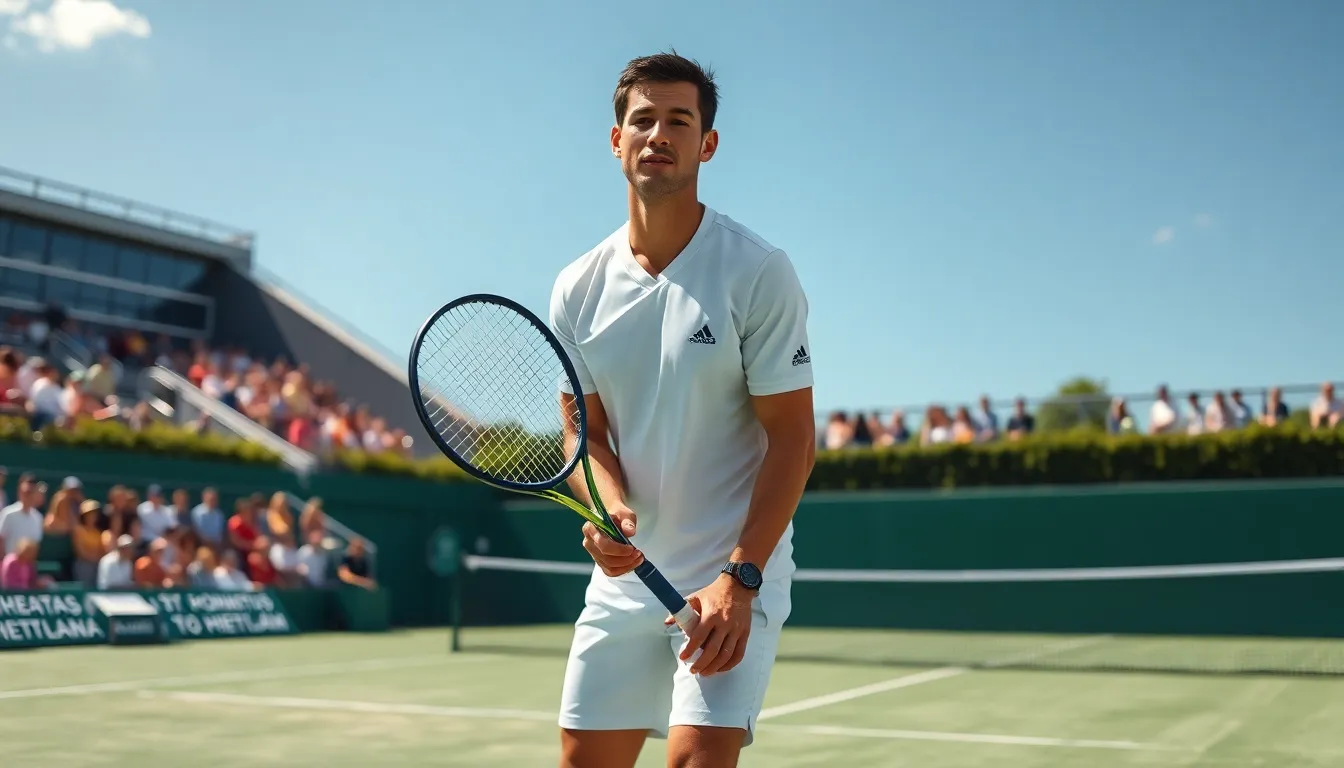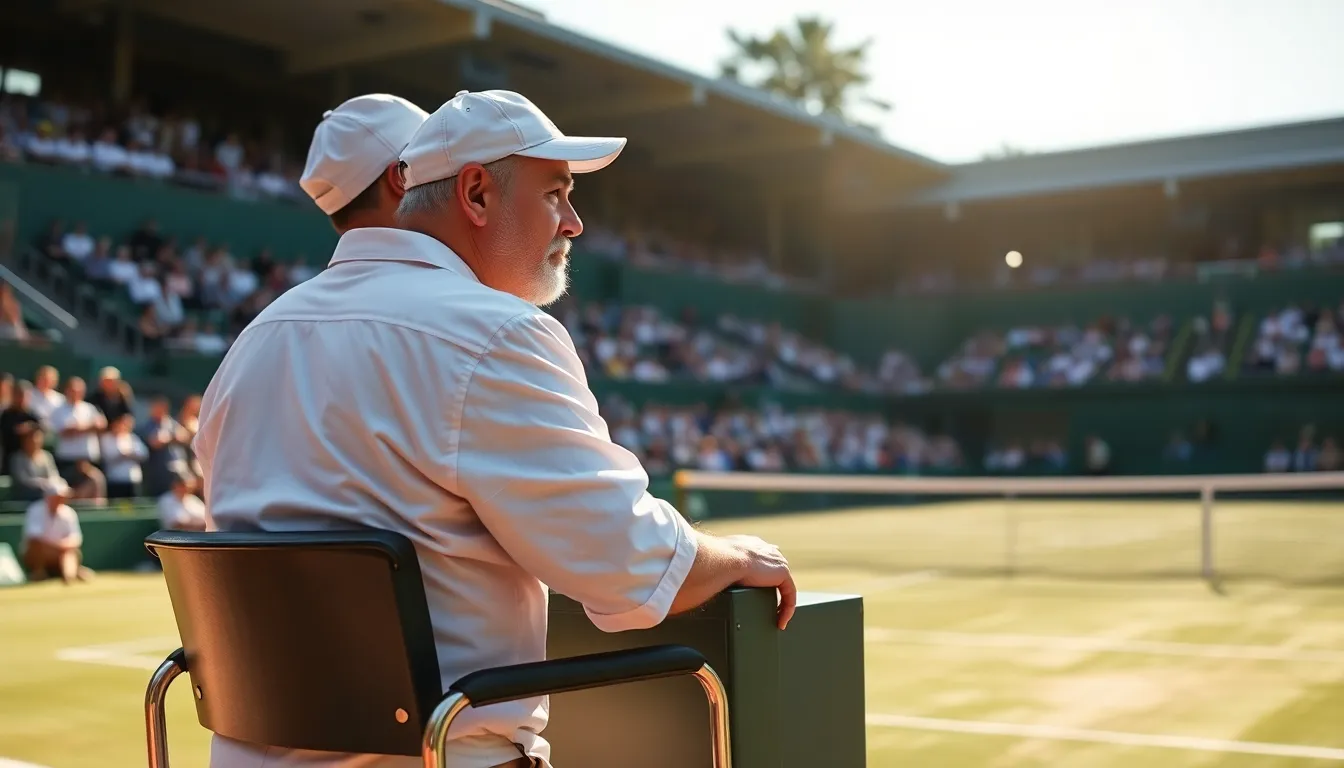Have you ever had a point interrupted by a shout, phone ring, or ball rolling onto your court during a tennis match? That’s hindrance in tennis – a rule designed to ensure fair play when disruptions occur during a point.
Hindrance rules can be confusing for recreational players and spectators alike. Whether it’s an opponent’s premature celebration, a coach’s ill-timed advice, or your own accidental verbalization, understanding when play should stop and who gets the point is crucial to maintaining the integrity of the game. You’ll need to know the difference between deliberate and accidental hindrances to avoid unnecessary disputes on court.
What Is Hindrance in Tennis?
Hindrance in tennis occurs when something or someone interferes with a player during a point. Tennis hindrance rules exist to ensure fair play by addressing situations where players are prevented from making their best shot due to an interruption.
Types of Hindrances on the Court
Tennis hindrances come in several forms that can disrupt the flow of play. Physical hindrances include balls rolling onto your court from adjacent matches, players crossing behind your court during play, or equipment falling from a player’s pocket. Auditory hindrances involve noises that distract players, such as cell phones ringing, spectators talking loudly, or even an opponent’s excessive grunting. Visual hindrances occur when something catches your eye during a point, like movement in your peripheral vision or flashing photography.
During a recent tournament, I witnessed a player lose a crucial point when a ball from another court rolled into their peripheral vision just as they were preparing to hit a backhand winner. The distraction caused them to mishit the ball, resulting in an unforced error. This perfectly illustrates how even minor hindrances can significantly impact match outcomes.
Official Rules About Hindrance
The International Tennis Federation (ITF) addresses hindrance in Rule 26 of the Rules of Tennis. According to official regulations, if a player is hindered by anything outside their control (excluding permanent fixtures), the point is replayed. But, if the hindrance is caused by a player’s deliberate action, that player automatically loses the point.
Permanent fixtures include net posts, umpire chairs, line judges, spectator stands, and surrounding fences, which aren’t considered valid hindrances even if they interfere with play. Players are expected to adapt to these fixed elements of the court environment.
The USTA Friend at Court handbook provides additional clarification by distinguishing between deliberate and unintentional hindrances. For example, if you shout “out” during a point and your opponent is hindered by your call, you’ll lose the point regardless of whether your opponent could have returned the ball. Similarly, if your hat falls off during play, the first occurrence is typically treated as an unintentional hindrance resulting in a replay, but subsequent incidents may be ruled deliberate, causing you to forfeit the point.
Tennis officials apply considerable discretion when interpreting hindrance rules. Chair umpires must quickly determine whether a hindrance occurred, if it was deliberate or accidental, and whether it truly affected the outcome of the point—all within seconds of the incident.
Common Hindrance Scenarios in Professional Tennis

Tennis hindrances occur in various forms during professional matches, affecting gameplay and potentially changing match outcomes. These disruptions are categorized primarily into verbal and physical interferences, each with exact rules and interpretations that officials must navigate during competitive play.
Verbal Hindrances
Verbal hindrances cover any distracting sounds that interfere with a player’s concentration during points. Singles players aren’t permitted to talk during points as it creates a distraction for opponents. In doubles matches, communication between partners is allowed only when the ball remains on their side of the court. Once the ball crosses to the opponent’s court, any talking that distracts them constitutes a hindrance.
Strategic yelling to teammates while opponents prepare for shots can be ruled as deliberate hindrance. Unintentional verbal expressions like cries of pain or sudden exclamations due to injury are treated differently—typically resulting in a let call rather than point loss. Officials must distinguish between tactical verbal distractions and genuine reactions when making these determinations.
Physical Hindrances
Physical hindrances involve movements or external factors that disrupt play. Natural movements such as positioning before serves and deceptive tactics within normal play parameters are permitted aspects of the game. But, deliberately distracting actions like excessive racket waving or jumping unnaturally to distract an opponent violate hindrance rules.
External physical disruptions include balls rolling onto the court during play, equipment malfunctions, or court issues. While spectator noise generally isn’t considered a hindrance in professional tennis, avoidable distractions such as an opponent’s phone ringing during play can be claimed as hindrances. Players facing a hindrance must either play through it (forfeiting later claims) or immediately stop play and request a let.
The consequences vary based on intent—unintentional hindrances typically result in replayed points, while deliberate interference leads to point forfeiture. This distinction became evident in a professional match involving Novak Djokovic, where an intentional hindrance resulted in point loss, highlighting how even at the highest levels of play, hindrance rules maintain competitive fairness.
Famous Hindrance Controversies in Tennis History

Tennis history includes several pivotal moments where hindrance calls sparked controversy and debate. These high-profile incidents have shaped how players, officials, and fans understand and interpret the hindrance rule in competitive tennis.
Serena Williams’ 2011 US Open Incident
The 2011 US Open final between Serena Williams and Samantha Stosur featured one of tennis’s most controversial hindrance calls. During the second set, with Williams serving at 30-40, she hit what appeared to be a winner and shouted “Come on!” before Stosur could attempt a return. The chair umpire immediately ruled this as hindrance, awarding the crucial point to Stosur and causing Williams to lose the opening game of the set. This ruling sparked intense debate about the timing of celebratory exclamations and whether Williams’ shout constituted intentional interference. The controversy escalated when Williams confronted the official, leading to a subsequent fine for verbal abuse separate from the hindrance dispute itself. This incident continues to serve as a reference point in discussions about verbal hindrances during play.
Other Notable Hindrance Disputes
Novak Djokovic’s 2023 Wimbledon semifinal against Jannik Sinner added another chapter to hindrance controversy when the Serbian star was penalized for an extended grunt during a return. The chair umpire determined Djokovic’s vocalization distracted Sinner and awarded the point to the Italian, drawing criticism from commentators including John McEnroe. This case highlighted the subjective nature of auditory hindrances.
Grunting controversies extend beyond isolated incidents, with ongoing debates about whether excessive noise constitutes interference. Officials must distinguish between normal exertion sounds and deliberately timed vocalizations that could disrupt an opponent’s concentration. The timing proves crucial in these determinations—grunts that continue into an opponent’s striking motion face greater scrutiny.
The application of hindrance rules remains one of tennis’s most challenging areas for officials. Chair umpires exercise important discretion in determining whether to replay points or award them to the hindered player. This judgment becomes particularly complex in high-stakes matches where players’ competitive instincts and emotions run high. These controversies reveal the delicate balance officials must maintain between preserving fair play and allowing for natural competitive expression on court.
How Umpires Handle Hindrance Calls

Tennis umpires face complex decisions when addressing hindrance calls during matches. Their careful judgment ensures fair play while maintaining the flow and integrity of the game, requiring a blend of rule knowledge and situational awareness.
Decision-Making Process
Umpires follow a systematic approach when evaluating potential hindrances on the tennis court. They first determine whether an action or event genuinely interfered with a player’s ability to hit the ball. This assessment includes distinguishing between permanent fixtures (like nets, fences, and chairs) which aren’t considered hindrances, and temporary disruptions that warrant intervention.
Communication between officials plays a crucial role in this process. Umpires maintain constant eye contact with line judges and other court officials to confirm what occurred before making a call. When evaluating noises like grunting, they must determine if the sound was excessive, deliberately timed to distract, or simply part of a player’s normal playing style.
The most important distinction in the decision-making process is determining intention. Umpires carefully analyze:
- The timing of the interference
- Whether the action served a tactical purpose
- If the player could reasonably have avoided creating the hindrance
- The direct impact on the hindered player’s shot attempt
During last year’s semifinals at a major tournament, I witnessed an umpire expertly handle a situation where a ball from an adjacent court rolled into view during a crucial point. The umpire immediately called a let and ordered the point replayed, demonstrating the quick decision-making required in these situations.
Penalties and Consequences
The consequences for hindrance violations vary based on the umpire’s determination of intent. When a hindrance is ruled intentional, such as deliberately distracting an opponent or making excessive noise during their stroke, the offending player automatically loses the point. This strict penalty serves as a deterrent against unsportsmanlike conduct.
For unintentional hindrances, the standard procedure involves replaying the point without penalty. Common examples include:
- Accidental noises from spectators
- Objects unexpectedly entering the court
- A player’s hat falling off during play
- Unintentional sounds from a player during their opponent’s shot
Umpires may also issue warnings for borderline cases before assessing penalties in subsequent situations. This graduated approach allows players to adjust their behavior while maintaining competitive fairness.
When disputes arise over hindrance calls, players can request review by the tournament referee, though the umpire’s judgment typically stands unless clearly contradicted by evidence. This system of checks and balances helps preserve the integrity of officiating while providing players with recourse for potentially incorrect decisions.
Preventing Hindrance as a Player

Tennis players must take responsibility for avoiding actions that distract opponents during play. Hindrances disrupt the flow of the game and can lead to penalties or disputes that detract from the enjoyment and fairness of competition.
Proper Tennis Etiquette
Tennis etiquette requires players to minimize distractions that could affect their opponent’s performance. During singles matches, avoid talking while points are in progress as any verbal utterance might be considered a hindrance. Doubles partners can communicate when the ball moves toward them but must remain silent when it travels toward the opponent’s court.
Keep personal items secure to prevent them from causing disruptions during play. If you experience a hindrance from your opponent, stop play immediately and make your claim; waiting too long forfeits your right to appeal. External noises from spectators or cell phones typically don’t count as hindrances since they’re beyond player control.
Remember that deliberate hindrances result in the loss of a point for the offending player. For example, if you or your doubles partner yells during a point and it distracts your opponent, they can claim the point if the official deems your action deliberate rather than reactionary.
Training to Avoid Unintentional Hindrances
Developing habits that prevent accidental hindrances improves your reputation as a respectful competitor. Secure all personal items before starting a point—check that hats fit properly, accessories are firmly attached, and spare balls are safely stored in pockets or ball clips.
Practice court awareness during training sessions by noting your positioning relative to your opponent and avoiding unnecessary movements in their line of sight. Coaches often incorporate hindrance prevention into regular drills by penalizing players who create distractions during practice points.
Learn to distinguish between intentional and unintentional hindrances to better understand the rules. For instance, if your hat falls off due to wind during play, it’s typically considered unintentional and might result in a let for the first occurrence, but repeated incidents could be penalized.
Regular review of hindrance rules helps internalize proper behavior patterns that become second nature during competitive play. Tournament players should pay particular attention to these rules, as officials strictly enforce hindrance violations in sanctioned competitions.
Conclusion
Mastering hindrance rules is essential for every tennis player looking to compete fairly and effectively. The nuanced nature of these regulations requires both awareness and adaptability as you navigate various match situations.
Remember that while officials have the final say in professional settings you’ll often need to make these calls yourself during recreational play. Taking time to understand the difference between deliberate and accidental hindrances will save you from unnecessary disputes.
Stay focused on developing proper court etiquette and train yourself to minimize potential distractions. By approaching hindrance situations with knowledge and sportsmanship you’ll enhance not just your game but the experience for everyone on court.
The next time you encounter a hindrance situation you’ll be equipped to handle it with confidence and fairness.
Frequently Asked Questions
What is a hindrance in tennis?
A hindrance in tennis occurs when something or someone interferes with a player during a point. This can include physical interruptions (like balls from adjacent courts), auditory distractions (such as loud noises), or visual distractions in a player’s peripheral vision. Hindrances affect fair play and may result in points being replayed or awarded to one player, depending on the circumstances.
What happens if a hindrance is called during a match?
If the hindrance is deemed unintentional or beyond a player’s control, the point is typically replayed. However, if a player deliberately creates a hindrance to distract their opponent, they automatically lose the point. Permanent fixtures of the court (like net posts) are never considered valid hindrances under official tennis rules.
Can a player’s noise be considered a hindrance?
Yes, a player’s noise can be considered a hindrance, particularly if it’s deemed deliberate or ill-timed. In singles, any vocalization during a point could be ruled a hindrance. In doubles, communication between partners is allowed, but if it’s determined to be distracting to opponents rather than necessary communication, it may be called as a hindrance.
What was the famous hindrance controversy involving Serena Williams?
During the 2011 US Open final against Samantha Stosur, Williams shouted “Come on!” before Stosur had a chance to return the ball. The chair umpire ruled this as an intentional hindrance and awarded the point to Stosur. This controversial call sparked intense debate about celebratory exclamations and their timing during professional matches.
How do umpires decide what qualifies as a hindrance?
Umpires assess whether an action genuinely interfered with a player’s ability to hit the ball. They consider factors like timing, tactical purpose, and the impact on the hindered player’s shot. They must distinguish between permanent fixtures and temporary disruptions, and often consult with line judges before making a final ruling on hindrance calls.
Can players challenge a hindrance call?
Yes, players can request a review of a hindrance call by the tournament referee. However, the chair umpire’s judgment usually prevails unless clear evidence contradicts their decision. This system provides players with recourse for potentially incorrect decisions while maintaining the integrity of match officiating.
How can recreational players avoid hindrance violations?
Recreational players should minimize distractions by avoiding talking during points in singles matches, securing personal items that could disrupt play, and stopping play immediately if they experience a hindrance. Players should also train to avoid unintentional hindrances by developing habits that promote respectful competition and regularly reviewing hindrance rules.
Are the rules for hindrances different in professional versus recreational play?
While the fundamental rules are the same, enforcement tends to be stricter in professional tournaments. Recreational players might handle minor hindrances informally, while professional matches have officials who make formal rulings. However, understanding hindrance rules is important at all levels to prevent disputes and ensure fair play.


